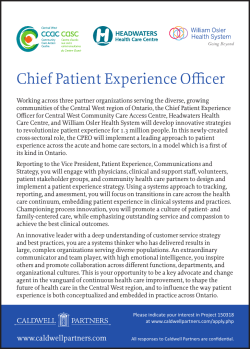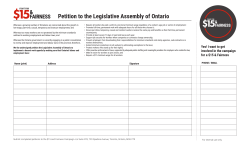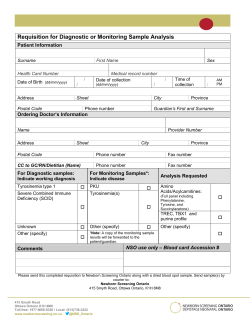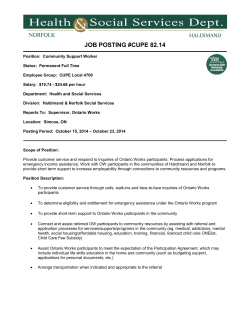
Mi$$ing Links: Infrastructure Financing Tools & Smart Growth
Mi$$ing Links: Infrastructure Financing Tools & Smart Growth April 29, 2015 Dave Marshall J.D./M.P.P. Candidate, 2016 Sandy & Blanche Van Ginkel Graduate Fellow Institute on Municipal Finance and Governance Munk School of Global Affairs University of Toronto da.marshall@mail.utoronto.ca Smart Growth + Infrastructure Financing 2 Introduction - - Smart Growth is not solely the domain of urban planners We can create new infrastructure financing and funding combinations that both provide municipal funding autonomy and support smart growth outcomes The cost of ignoring the inherent smart growth implications of financing/funding tools might be very high 3 Roadmap 1. Smart Growth 2. Infrastructure Financing 3. Towards Integration 4 Source: http://piayoungplanners.blogspot.ca/ 5 Smart Growth Priorities Mix Land Uses Take Advantage of Compact Building Design Create a Range of Housing Opportunities and Choices Create Walkable Neighborhoods Foster Distinctive, Attractive Communities with a Strong Sense of Place Preserve Open Space, Farmland, Natural Beauty, and Critical Environmental Areas Strengthen and Direct Development Towards Existing Communities Provide a Variety of Transportation Choices Make Development Decisions Predictable, Fair, and Cost Effective Encourage Community and Stakeholder Collaboration in Development Decisions Source: United States Environmental Protection Agency 6 Source: Ontario Growth Secretariat, 2006 7 Source: Ontario Growth Secretariat, 2006 8 Presenter’s Calculations 2006-10 Data from Statistics Canada, Canada Post, esri Inc. Source: Statistics Canada, Canada Post, Ontario Growth Secretariat 2006, ESRI, Authors’ Calculations. 9 Presenter’s Calculations Data from Statistics Canada, Canada Post, Ontario Growth 2011-15 Secretariat, esri Inc. Source: Statistics Canada, Canada Post, Ontario Growth Secretariat 2006, ESRI, Authors’ Calculations. 10 2006-10 2006-10 Geography: Mississauga (zoom) 2011-15 2011-15 Source: Statistics Canada, Canada Post, Ontario Growth Secretariat 2006, ESRI, Authors’ Calculations. 11 2006-10 2011-15 Geography: Waterloo Region Source: Statistics Canada, Canada Post, Ontario Growth Secretariat 2006, ESRI, Authors’ Calculations. 12 Geography: York Region 2006-10 2011-15 Source: Statistics Canada, Canada Post, Ontario Growth Secretariat 2006, ESRI, Authors’ Calculations. 13 Caveats 1. We can still approach infrastructure planning in ways that more reliably make smart growth a priority 2. The link with infrastructure financing appears to be missing 14 Source: sodahead.com 15 “The link between infrastructure financing and planning is one that is often overlooked...” DR. RAY TOMALTY Source: SmartGrowthBC, 2007 16 Plan >> Finance >> Fund >> Deliver Adapted from Vander Ploeg, 2006 17 Plan What? and Where? >> Finance Borrow and/or Pay-as-you-go >> Fund General Revenues and/or Specific Revenues >> Deliver Public ad/or Private Adapted from Vander Ploeg, 2006 18 Plan What? and Where? >> Finance Borrow and/or Pay-as-you-go >> Fund General Revenues and/or Specific Revenues >> Deliver Public ad/or Private Adapted from Vander Ploeg, 2006 19 Finance Fund Borrowing General Revenues (Tax) Short-term Borrowing Long-term Borrowing Borrowing Against Anticipated Revenue Pay-as-you-go Property Tax Intergovernmental Grants >> Specific Revenues (User Fee or Tax) Transfers from Current Revenue Special Assessments Intergovernmental Grants Tax Revenue Sharing Reserve Funds Operating/Capital Leases Local Improvement Levies Specific Taxes Traditional User Fees Development Charges Adapted from Vander Ploeg, 2006 20 Option A Borrowing General Revenues (Tax) Short-term Borrowing Long-term Borrowing Borrowing Against Anticipated Revenue Pay-as-you-go Property Tax Intergovernmental Grants >> Specific Revenues (User Fee or Tax) Transfers from Current Revenue Special Assessments Intergovernmental Grants Tax Revenue Sharing Reserve Funds Operating/Capital Leases Local Improvement Levies Specific Taxes Traditional User Fees Development Charges Adapted from Vander Ploeg, 2006 21 Option B Borrowing General Revenues (Tax) Short-term Borrowing Long-term Borrowing Borrowing Against Anticipated Revenue Pay-as-you-go Property Tax Intergovernmental Grants >> Specific Revenues (User Fee or Tax) Transfers from Current Revenue Special Assessments Intergovernmental Grants Tax Revenue Sharing Reserve Funds Operating/Capital Leases Local Improvement Levies Specific Taxes Traditional User Fees Development Charges Adapted from Vander Ploeg, 2006 22 Option C Borrowing General Revenues (Tax) Short-term Borrowing Long-term Borrowing Borrowing Against Anticipated Revenue Pay-as-you-go Property Tax Intergovernmental Grants >> Specific Revenues (User Fee or Tax) Transfers from Current Revenue Special Assessments Intergovernmental Grants Tax Revenue Sharing Reserve Funds Operating/Capital Leases Local Improvement Levies Specific Taxes Traditional User Fees Development Charges Adapted from Vander Ploeg, 2006 23 Option A = $100 million Option B = $100 million Option C = $100 million 24 Option A = $100 million – all who pay property tax Option B = $100 million – all users Option C = $100 million – Ontario taxpayers + users 25 A Smart Growth Lens An examination of various financing tools, categorized accordingly by Dr. Ray Tomalty (Tomalty, 2007): • Tools that inherently encourage smart growth by virtue of how revenue is raised • • • Linking charges to use Reducing fiscal disparities between parcels of an urban region Taxing inefficient land uses • Tools that encourage smart growth by virtue of the way in which the revenue is spent • Requires coordination between land use planning and infrastructure decisions 26 Inherently Smart-Growth Promoting Smart Growth is Spending-Dependent Gradient Development Charges Tax Increment Financing* Fuel Taxes Marginal Cost User Fees Land Value Taxation Average Cost User Fees Standard Development Charges Vehicle Registration Surcharges Intergovernmental Grants Property Taxes / General Revenues Adapted from Tomalty, 2007 27 Finance Fund Borrowing General Revenues (Tax) Short-term Borrowing Long-term Borrowing Borrowing Against Anticipated Revenue Pay-as-you-go Property Tax Intergovernmental Grants >> Specific Revenues (User Fee or Tax) Transfers from Current Revenue Special Assessments Intergovernmental Grants Tax Revenue Sharing Reserve Funds Operating/Capital Leases Local Improvement Levies Specific Taxes Traditional User Fees Development Charges Adapted from Vander Ploeg, 2006 28 Ontario (O.Reg 403/02) Borrow 25% of certain annual revenues or receipts, less most ongoing annual long-term debt service costs 29 Ontario (O.Reg 289/11) Borrow 25% of certain annual revenues or receipts, less most ongoing annual long-term debt service costs + 80% of DCs (York Region Only) 30 Ontario (O.Reg 403/02) 25% of revenues… General + York i. as grants from the Government of Ontario or Canada or from another municipality, ii. as proceeds from the sale of real property, iii. as a contribution or transfer from a reserve fund or reserve, iv. under agreement with the Government of Ontario, for the purpose of repaying the principal and interest of long-term debt or meeting financial obligations of the municipality, v. from another municipality or a school board for the repayment of the principal and interest of long-term debt of the municipality borrowed for the exclusive purposes of the other municipality or school board, vi. as revenues from electrical, telephone and gas service… Development Charge Revenue (3 year average) 31 Geography: York Region 2006-10 2011-15 Source: Statistics Canada, Canada Post, ESRI, Authors’ Calculations. 32 Three Observations 1. Smart Growth is not the exclusive domain of urban planners 2. New tools for smart growth that preserve municipal funding autonomy for infrastructure 3. New opportunities for the development of unique funding tools emerge 33 Inherently Smart-Growth Promoting Smart Growth is Spending-Dependent Gradient Development Charges Tax Increment Financing* Fuel Taxes Marginal Cost User Fees Land Value Taxation Average Cost User Fees Standard Development Charges Vehicle Registration Surcharges Intergovernmental Grants Property Taxes / General Revenues Adapted from Tomalty, 2007 34 Where Do We Go From Here? 35 Plan >> Finance >> Fund >> Deliver Adapted from Vander Ploeg, 2006 36 Plan + Finance + Fund + Deliver Smart Growth 37 Inherently Smart-Growth Promoting Smart Growth is Spending-Dependent Gradient Development Charges Tax Increment Financing* Fuel Taxes Marginal Cost User Fees Land Value Taxation Average Cost User Fees Standard Development Charges Vehicle Registration Surcharges Intergovernmental Grants Property Taxes / General Revenues Adapted from Tomalty, 2007 38 Adapting Existing Tools - Change Development Charges legislation - - Change Discretionary Grant Criteria - - Permit or enforce density- or sector-gradient DCs Potential progress being made by the Ontario Government’s Bill 6 (March 2015) Require smart growth compliance or growth considerations as part of longterm asset planning Change ARL (Annual Repayment Limit) - Promote use of smart-growth promoting funding mechanisms by permitting municipalities to borrow against revenue generated through these tools 39 Inherently Smart-Growth Promoting Smart Growth is Spending-Dependent Gradient Development Charges Tax Increment Financing* Fuel Taxes Marginal Cost User Fees Land Value Taxation Average Cost User Fees Standard Development Charges Vehicle Registration Surcharges Intergovernmental Grants Property Taxes / General Revenues Adapted from Tomalty, 2007 40 Creating New Tools - Pay-as-you-go - - Provide municipalities with additional taxation tools, particularly for special assessments “Smart Growth Bonds” - Revenue-backed bonds for municipalities Projects must be smart growth-enhancing or compliant and tied to an inherently smart-growth promoting funding source Provide provincial credit enhancement to promote investment Exempt from provincial taxes to reduce cost of borrowing for municipalities 41 Conclusions - The way we pay for infrastructure can have wide-ranging applications There may be ways to re-orient the way we think about the infrastructure financing, funding & delivery process as a whole Potential opportunities exist to use this process to support smart growth outcomes At the very least, we should ensure that we are not inadvertently undercutting our smart growth efforts through funding and financing tools 42 Mi$$ing Links: Infrastructure Financing Tools & Smart Growth April 29, 2015 Dave Marshall J.D./M.P.P. Candidate, 2016 Sandy & Blanche Van Ginkel Graduate Fellow Institute on Municipal Finance and Governance Munk School of Global Affairs University of Toronto da.marshall@mail.utoronto.ca Public Distribution Version, Checked Against Delivery Appendix A Sources "What Is Smart Growth?" About Smart Growth. United States Environmental Protection Agency, n.d. Web. 5 Apr. 2015. <http://www2.epa.gov/smart-growth/about-smart-growth>. Ontario. Ministry of Municipal Affairs and Housing. Ontario Growth Secretariat. Growth Plan for the Greater Golden Horseshoe. Government of Ontario, Mar. 2006. Web. 15 Apr. 2015. <https://www.placestogrow.ca/index.php?option=com_content&task=view&id=359&Itemid=12>. Tomalty, Ray. Innovative Infrastructure Financing Mechanisms for Smart Growth. Rep. SmartGrowthBC, Dec. 2007. Web. 5 Apr. 2015. <http://www.smartgrowth.bc.ca/Portals/0/Downloads/sgbc-infrastructure-reportweb.pdf>. Vander Ploeg, Casey. New Tools for New Times: A Sourcebook for the Financing, Funding and Delivery of Urban Infrastructure. Rep. Canada West Foundation, Sept. 2006. Web. 5 Apr. 2015. <http://cwf.ca/pdfdocs/publications/New-Tools-for-New-Times-September-2006.pdf>. 45 Data Sources Canada Post. Business and Residential Counts and Maps, 2015. 3 Apr. 2015. Raw data. https://www.canadapost.ca/cpotools/mc/app/tpo/pym/targeting.jsf, Toronto. Ontario. Ministry of Municipal Affairs and Housing. Ontario Growth Secretariat. Growth Plan for the Greater Golden Horseshoe. Government of Ontario, Mar. 2006. Web. 15 Apr. 2015. <https://www.placestogrow.ca/index.php?option=com_content&task=view&id=359&Itemid=12>. Statistics Canada. Population and dwelling counts, for Canada and forward sortation areas as reported by the respondents, 2011 Census. 17 Apr. 2015. Raw data. http://www12.statcan.gc.ca/censusrecensement/2011/dp-pd/hlt-fst/pd-pl/Table-Tableau.cfm?LANG=Eng&T=1201&S=22&O=A, Ottawa. Statistics Canada. Population and dwelling counts, for Canada and forward sortation areas as reported by the respondents, 2006 Census. 1 June 2010. Raw data. https://www12.statcan.gc.ca/censusrecensement/2006/dp-pd/hlt/97-550/Index.cfm?TPL=P1C&Page=RETR&LANG=Eng&T=1201&S=0&O=A, Ottawa. 46 Relevant Legislation Places to Grow Act, 2005, S.O. 2005, c. 13 (http://www.ontario.ca/laws/statute/05p13?search=places+to+grow+act) O. Reg. 416/05: GROWTH PLAN AREAS (http://www.ontario.ca/laws/regulation/050416?search=places+to+grow+act) Municipal Act, 2001, S.O. 2001, c. 25 (http://www.ontario.ca/laws/statute/01m25?search=Municipal+Act%2C+S.O.) O. Reg. 403/02: DEBT AND FINANCIAL OBLIGATION LIMITS (http://www.ontario.ca/laws/regulation/020403?search=Municipal+Act%2C+S.O.) City of Toronto Act, 2006, S.O. 2006, c. 11, Sched. A (https://www.ontario.ca/laws/statute/06c11?search=city+of+toronto+act+s.o.) Tax Increment Financing Act, 2006, S.O. 2006, c. 33 , Sched. Z.7 (http://www.ontario.ca/laws/statute/06t33?search=tax+increment+financing) No regulations currently exist 47
© Copyright 2025









